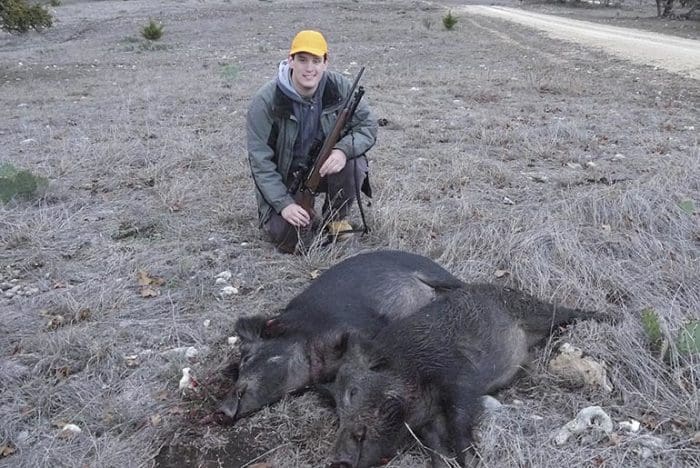Deer, pigs, elk and other game animals can carry brucellosis. Know how to protect yourself this fall.
Hunting feral hogs is big business here in Texas and other states. The critters are widespread throughout the southeast and west coast. And they’re spreading.
A hog hunt, one in which you bag a single pig, can run you upwards of $500 (not including food, ammo, rifle…). The good news is that in Texas and many other states, hogs are considered invasive non-game animals that can be hunted year-round with no bag limit.
They’re enough of a problem in these parts that to help in the ongoing anti-swine efforts, you don’t even need a license to hunt them here in Texas any more.
Feral hogs are terrible, destructive animals that cause hundreds of millions of dollars of damage every year. So hunters reducing the population of these delicious creatures benefits everyone.
But according to the Centers for Disease Control and Prevention, feral hogs — like other free-ranging wild critters — can pose a risk to hunters above and beyond the regular traumatic variety.
Wild hogs can carry brucellosis, a nasty bacterial infection. From the CDC . . .
People can get the disease when they are in contact with infected animals or animal products contaminated with the bacteria.
If you are a hunter of particular wild animals, you may face an increased risk of brucellosis. This is because hunters are often exposed to the blood and organs of the animals they are hunting.
For those who slept through microbiology, brucella bacteria, which causes brucellosis, is a gram negative disease of the nervous system. That means traditional antibiotics are less effective against the disease.
Again from the CDC . . .
Signs and symptoms of brucellosis can include fever, chills, sweating, headache, low appetite, fatigue, and joint or muscle pain.
It may take anywhere from a week up to a month after coming into contact with the infected animal for you to start feeling sick. See a doctor right away if you experience these signs and symptoms. Be sure to tell your doctor about your contact with wild animals, especially wild hogs, deer, moose, elk, and bison. Your doctor can test your blood for brucellosis.
If you contract it, the symptoms can persist throughout your life. It can be treated with a lengthy course of modern antibiotics like Gentamicin, but it’s a bacterial disease that’s no fun at all while you have it.
While pigs are particularly nasty and some of the most frequent carriers, they aren’t the only critters that pose a brucellosis transmission risk. Besides feral swine, these game animals can carry it, too:
-
- elk
- bison
- caribou
- moose
- deer
That’s right, even Bambi can infect you. But there are some basic safety tips you can use to avoid exposure.
How to Reduce the Risk of Brucellosis Exposure
According to the CDC, the risk of infection is highest when coming into direct contact with the blood and organs of wild animals. Transmission appears to be most prevalent during a blood-to-blood contact (handling bloody parts with an open cut), but anywhere wet on your body (eyes, mouth) can be a prime location for transmission.
With fall hunting season (finally!) approaching, how can hunters protect themselves from the bacterial threat?
Say it with me: body substance isolation. You need to avoid contact with blood, urine, feces and other bodily fluids when you’re out in the field.
This video we filmed a few years ago shows good field dressing body substance isolation practices. Note that while gutting this deer, Tyler was wearing both latex gloves and eye protection.
Field Dressing Safety Tips
Here are some safety tips you should follow to avoid brucellosis exposure when hunting this fall:
- Use clean, sharp knives for field dressing and butchering.
- Wear eye protection and rubber or latex gloves (disposable or reusable) when handling carcasses.
- Avoid direct (bare skin) contact with fluid or organs from the animal.
- Avoid direct (bare skin) contact with hunting dogs that may have come into contact with hunted animals.
- After butchering, burn or bury disposable gloves and parts of the carcass that will not be eaten.
- Don’t feed dogs with raw meat or other parts of the carcass.
- Wash hands as soon as possible with soap and warm water for 20 seconds or more. Dry hands with a clean cloth.
- Clean all tools and reusable gloves with a disinfectant, like diluted bleach. (Follow the safety instructions on the product label).
- Thoroughly cook meat from any animal that is known to be a possible carrier of brucellosis (see the list above).
- Be aware that freezing, smoking, drying and pickling do not kill the bacteria that cause brucellosis.
Remember, when you take that 400-pound hog or 14-point buck this fall, keep basic body substance isolation practices in mind. It’s really pretty easy. Before you start to field dress or butcher, grab the latex or rubber gloves first. And keep your eye protection on.
